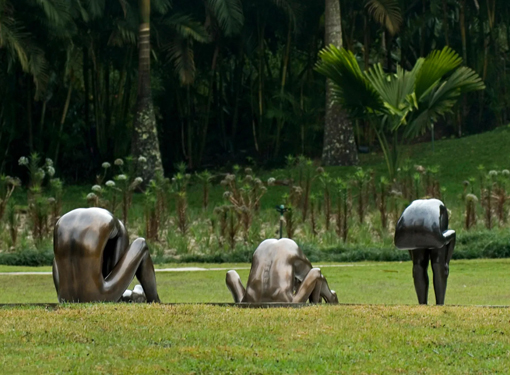Shocking.
What could the human concept be of Edgard de Souza, when a human is depicted without a head, with the head in the sand, with four legs?
A man bowing down without head is submissive and dependent on an authority that gives commands. This person is standing on his own feet and still could change, in theory. This hope fails because the head is missing, so the person is not capable for independent and creative thinking.
The other person has stretched legs, has pushed the shoulders hard against the ground, let his head disappear in the ground. This indicates self-destruction which is the most nihilistic act. Assuming that the person has a head, he would be able to turn into a creative, independent and caring person. This can be difficult but that doesn't matter.
The question can be asked if a body with four legs and a torso (but no head or arms) can be called a person. Because of the lack of the head and the arms, it is not possible to act authentic and independent.
How shocking is the human concept of Edgard de Souza, if a person is characterised as submissive, self-destructive, no-person?
By Theo, www.artatsite.com
Vertaling
Schokkend.
Wat zou het mensbeeld van Edgard de Souza kunnen zijn, als een mens is afgebeeld zonder hoofd, het hoofd in het zand, met vier benen?
Een buigende mens zonder hoofd is onderdanig en afhankelijk van een autoriteit die opdrachten geeft. Deze persoon staat op eigen benen en zou in theorie nog kunnen veranderen. Deze hoop vervliegt doordat het hoofd ontbreekt en de persoon daardoor niet zelfstandig en creatief kan denken.
De andere persoon heeft gestrekte benen, heeft de schouders hard tegen de grond gedrukt, laat het hoofd geheel verdwijnen in de grond. Dit duidt op zelfdestructie; dit is de meest nihilistische handeling. Ervan uitgaande dat de persoon een hoofd heeft, zou hij kunnen veranderen in een creatieve, zelfstandige en liefdevolle persoon. Dit is moeilijk maar dat geeft niet.
De vraag kan gesteld worden of je een lichaam met vier benen en een romp (maar zonder hoofd of armen) een persoon genoemd kan worden. Door het ontbreken van het hoofd en de armen is het niet mogelijk om als een authentiek en zelfstandig te handelen.
Hoe schokkend is het mensbeeld van Edgard de Souza als een persoon wordt getypeerd als onderdanig, zelfdestructief, geen-persoon?
Door Theo, www.artatsite.com
What could the human concept be of Edgard de Souza, when a human is depicted without a head, with the head in the sand, with four legs?
A man bowing down without head is submissive and dependent on an authority that gives commands. This person is standing on his own feet and still could change, in theory. This hope fails because the head is missing, so the person is not capable for independent and creative thinking.
The other person has stretched legs, has pushed the shoulders hard against the ground, let his head disappear in the ground. This indicates self-destruction which is the most nihilistic act. Assuming that the person has a head, he would be able to turn into a creative, independent and caring person. This can be difficult but that doesn't matter.
The question can be asked if a body with four legs and a torso (but no head or arms) can be called a person. Because of the lack of the head and the arms, it is not possible to act authentic and independent.
How shocking is the human concept of Edgard de Souza, if a person is characterised as submissive, self-destructive, no-person?
By Theo, www.artatsite.com
Vertaling
Schokkend.
Wat zou het mensbeeld van Edgard de Souza kunnen zijn, als een mens is afgebeeld zonder hoofd, het hoofd in het zand, met vier benen?
Een buigende mens zonder hoofd is onderdanig en afhankelijk van een autoriteit die opdrachten geeft. Deze persoon staat op eigen benen en zou in theorie nog kunnen veranderen. Deze hoop vervliegt doordat het hoofd ontbreekt en de persoon daardoor niet zelfstandig en creatief kan denken.
De andere persoon heeft gestrekte benen, heeft de schouders hard tegen de grond gedrukt, laat het hoofd geheel verdwijnen in de grond. Dit duidt op zelfdestructie; dit is de meest nihilistische handeling. Ervan uitgaande dat de persoon een hoofd heeft, zou hij kunnen veranderen in een creatieve, zelfstandige en liefdevolle persoon. Dit is moeilijk maar dat geeft niet.
De vraag kan gesteld worden of je een lichaam met vier benen en een romp (maar zonder hoofd of armen) een persoon genoemd kan worden. Door het ontbreken van het hoofd en de armen is het niet mogelijk om als een authentiek en zelfstandig te handelen.
Hoe schokkend is het mensbeeld van Edgard de Souza als een persoon wordt getypeerd als onderdanig, zelfdestructief, geen-persoon?
Door Theo, www.artatsite.com



